Birdwatching in Andalusia offers exceptional opportunities to observe over 400 bird species in diverse ecosystems. Key locations include Doñana National Park and the Sierra de Grazalema. Seasonal highlights feature migratory patterns in spring and autumn, showcasing unique species like the Iberian Magpie and the Spanish Imperial Eagle. Effective birdwatching techniques and recommended equipment enhance the experience in this rich avian paradise.

Why is Andalusia a Premier Destination for Birdwatching?
Andalusia is a premier destination for birdwatching due to its diverse ecosystems and rich biodiversity. The region hosts over 400 bird species, including unique migratory birds. Key locations like Doñana National Park and the Sierra de Grazalema provide optimal viewing opportunities. Seasonal highlights include the migration in spring and autumn, showcasing a variety of species.
What Unique Habitats Contribute to Bird Diversity in Andalusia?
Unique habitats in Andalusia, such as wetlands, mountains, and coastal areas, significantly enhance bird diversity. Wetlands like Doñana National Park provide crucial breeding grounds for species like the endangered Spanish imperial eagle. Mountainous regions, including the Sierra Nevada, support unique species such as the alpine chough. Coastal habitats along the Mediterranean attract migratory birds, offering vital stopover points. These diverse environments contribute to Andalusia’s rich birdwatching opportunities throughout the year.
How Does Climate Influence Birdwatching Opportunities Throughout the Year?
Climate significantly influences birdwatching opportunities in Andalusia by dictating species migration patterns and seasonal behaviors. Spring and autumn are prime times for observing migratory species, as many birds pass through this region. Summer showcases resident species, including the iconic Iberian magpie, while winter attracts northern species seeking milder climates.
Temperature variations affect bird activity; warmer months increase visibility and vocalizations, enhancing the birdwatching experience. Rainfall patterns also impact habitat conditions, influencing food availability and nesting sites.
The diverse ecosystems in Andalusia, such as wetlands and mountains, further enrich birdwatching throughout the year. Each season offers unique highlights, making it essential for birdwatchers to plan their visits accordingly to maximize sightings.
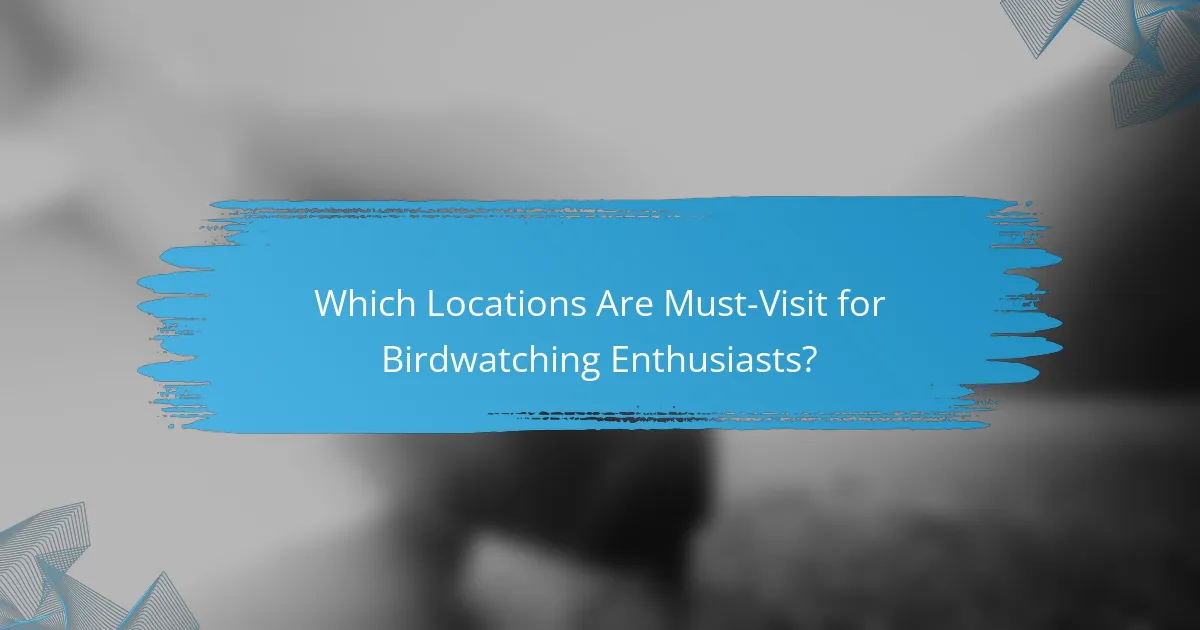
Which Locations Are Must-Visit for Birdwatching Enthusiasts?
Andalusia offers exceptional birdwatching locations, including Doñana National Park, Sierra de Grazalema, and the Guadalquivir River. These sites host diverse species such as the Iberian Magpie and the Griffon Vulture, especially during spring and autumn migrations.
What Are the Key Features of Doñana National Park for Birdwatchers?
Doñana National Park offers diverse habitats, making it a prime location for birdwatchers. Key features include extensive wetlands, marshes, and forests that attract various bird species. The park is home to over 300 bird species, including the endangered Spanish imperial eagle. Seasonal highlights feature migratory birds, particularly in spring and autumn, enhancing the birdwatching experience. Unique attributes include the park’s designation as a UNESCO World Heritage site, emphasizing its ecological significance.
How Does the Sierra de Grazalema Natural Park Enhance Birdwatching Experiences?
Sierra de Grazalema Natural Park significantly enhances birdwatching experiences with its diverse habitats and rich avian biodiversity. The park hosts over 200 bird species, including rare and endemic ones. Key features include varied ecosystems, such as mountains, forests, and wetlands, providing ideal conditions for bird nesting and migration. Notable species include the Griffon Vulture and the Bonelli’s Eagle, often spotted soaring above the stunning landscapes. Seasonal highlights occur during spring and autumn migrations, attracting birdwatchers eager to witness unique species.
Which Coastal Areas Offer Unique Birdwatching Opportunities?
Andalusia offers unique birdwatching opportunities in coastal areas like Doñana National Park and the Cabo de Gata-Níjar Natural Park. Doñana is renowned for its diverse habitats and migratory species, hosting over 300 bird species. Cabo de Gata features stunning landscapes and is home to endemic species such as the Audouin’s gull. Seasonal highlights include spring migrations, making these locations prime for birdwatching enthusiasts.

What Species Can Be Observed in Andalusia?
Andalusia is home to over 400 bird species, making it a prime location for birdwatching. Notable species include the Spanish Imperial Eagle, the Eurasian Griffon Vulture, and the Greater Flamingo. Seasonal highlights vary, with migratory birds like the Common Swift appearing in spring and winter visitors such as the Black Redstart. Key locations for observation include Doñana National Park, Sierra de Grazalema, and the wetlands of the Guadalquivir River.
Which Migratory Birds Visit Andalusia Seasonally?
Andalusia is a key stopover for migratory birds, with species such as the Eurasian Spoonbill, Black Stork, and Greater Flamingo visiting seasonally. These birds arrive primarily during spring and autumn, taking advantage of the region’s diverse habitats. The Guadalquivir River, Doñana National Park, and the Sierra de Grazalema are prime locations for birdwatching enthusiasts to observe these migratory species. Notably, the Eurasian Spoonbill showcases a unique characteristic with its distinct spoon-shaped bill, making it easy to identify.
What Endemic Species Are Exclusive to the Region?
Andalusia is home to several endemic bird species, including the Iberian magpie and the Spanish imperial eagle. These species thrive in the region’s diverse habitats, making it a prime location for birdwatching. The Iberian magpie, known for its striking plumage, is unique to the Iberian Peninsula, while the Spanish imperial eagle, a rare sight, is one of the most endangered birds of prey in Europe. Birdwatchers can observe these species in natural reserves and parks throughout Andalusia, especially during migration seasons.
How Do Local Conservation Efforts Impact Bird Populations?
Local conservation efforts significantly benefit bird populations by preserving habitats and enhancing biodiversity. In Andalusia, initiatives like habitat restoration and protected areas have led to increased sightings of various bird species. For example, the recovery of wetlands has boosted populations of migratory birds, including the endangered Purple Gallinule. These efforts also provide educational opportunities, fostering community involvement in birdwatching. As a result, local conservation not only supports avian diversity but also enriches the birdwatching experience in the region.
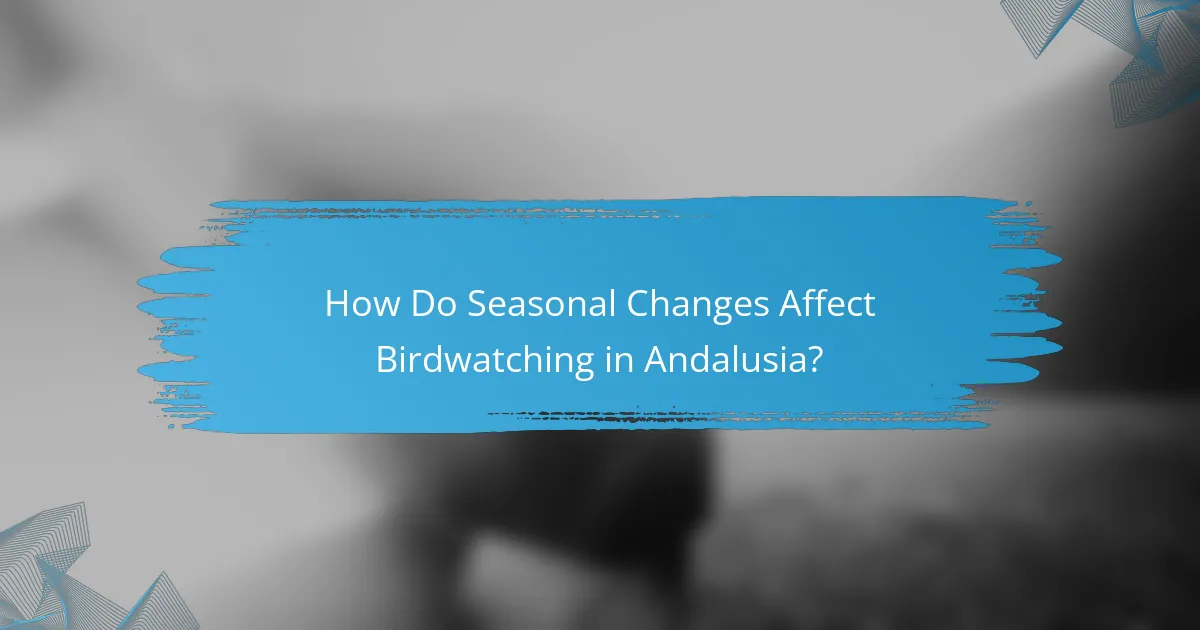
How Do Seasonal Changes Affect Birdwatching in Andalusia?
Seasonal changes greatly influence birdwatching in Andalusia, enhancing species diversity and visibility. Spring brings migratory birds, while autumn showcases unique local species.
Winter offers sightings of rare winter visitors, and summer highlights breeding activities. Each season presents distinct opportunities for birdwatchers to observe different species in their natural habitats.
What Are the Best Times of Year for Observing Specific Species?
The best times for observing specific bird species in Andalusia vary by season. Spring, particularly March to May, is ideal for migratory species like the European Bee-eater and the Common Swift. Summer months, June to August, are excellent for observing resident species, including the Iberian Magpie. Autumn, from September to November, offers opportunities to see migratory birds returning south, such as the Black Kite. Winter, especially December to February, is perfect for spotting species like the Eurasian Wren and various waterfowl in wetlands.
How Can Birdwatchers Prepare for Seasonal Variations in Bird Activity?
Birdwatchers can prepare for seasonal variations in bird activity by understanding migration patterns and adjusting their schedules accordingly. In Andalusia, spring and autumn are peak seasons for observing diverse species.
During spring, many migratory birds return, making it ideal for spotting species like the European Bee-eater and the Common Swift. In contrast, autumn offers opportunities to witness species such as the European Goldfinch and various raptors migrating south.
Birdwatchers should also consider local weather conditions, as they can influence bird activity. Rainy days may reduce visibility, while sunny days typically enhance bird movements.
Finally, utilizing regional resources, such as local birdwatching clubs or online forums, can provide insights into specific locations and timing for optimal birdwatching experiences.
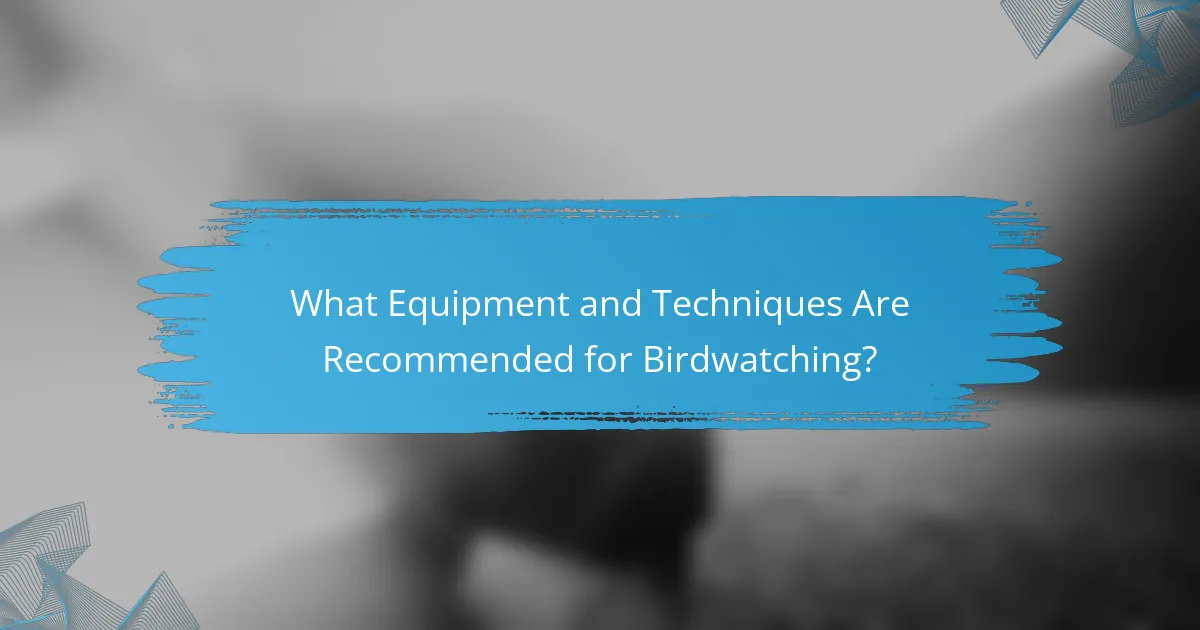
What Equipment and Techniques Are Recommended for Birdwatching?
For effective birdwatching in Andalusia, recommended equipment includes binoculars, a field guide, and a notebook. Techniques involve early morning observation, using camouflage, and maintaining silence.
Binoculars should have a magnification of 8×42 for optimal visibility. A field guide tailored to Andalusian species enhances identification. Keeping a notebook records sightings and behaviors, enriching the experience.
Seasonal highlights include migratory patterns in spring and autumn, making these times ideal for spotting diverse species. Birdwatching in wetlands and protected areas like Doñana National Park offers unique opportunities to observe rare birds.
Which Binoculars and Cameras Are Best for Birdwatching in Andalusia?
For birdwatching in Andalusia, high-quality binoculars and cameras enhance the experience. Recommended binoculars include the Swarovski EL 8.5×42, known for its clarity and brightness, and the Canon 10×42 L, which offers image stabilization. For cameras, the Canon EOS 90D and Nikon D7500 provide excellent image quality and versatility for capturing distant birds.
How Can Birdwatchers Improve Their Skills and Techniques?
Birdwatchers can improve their skills by practicing observation techniques, studying local habitats, and using quality equipment. Focus on identifying bird calls and behaviors to enhance your experience.
1. Visit diverse locations in Andalusia, such as Doñana National Park and Sierra de Grazalema, to observe various species.
2. Join local birdwatching groups for shared knowledge and tips.
3. Invest in binoculars with a magnification of at least 8×42 for better visibility.
4. Keep a journal to track sightings and notes on bird behavior and seasonal patterns.
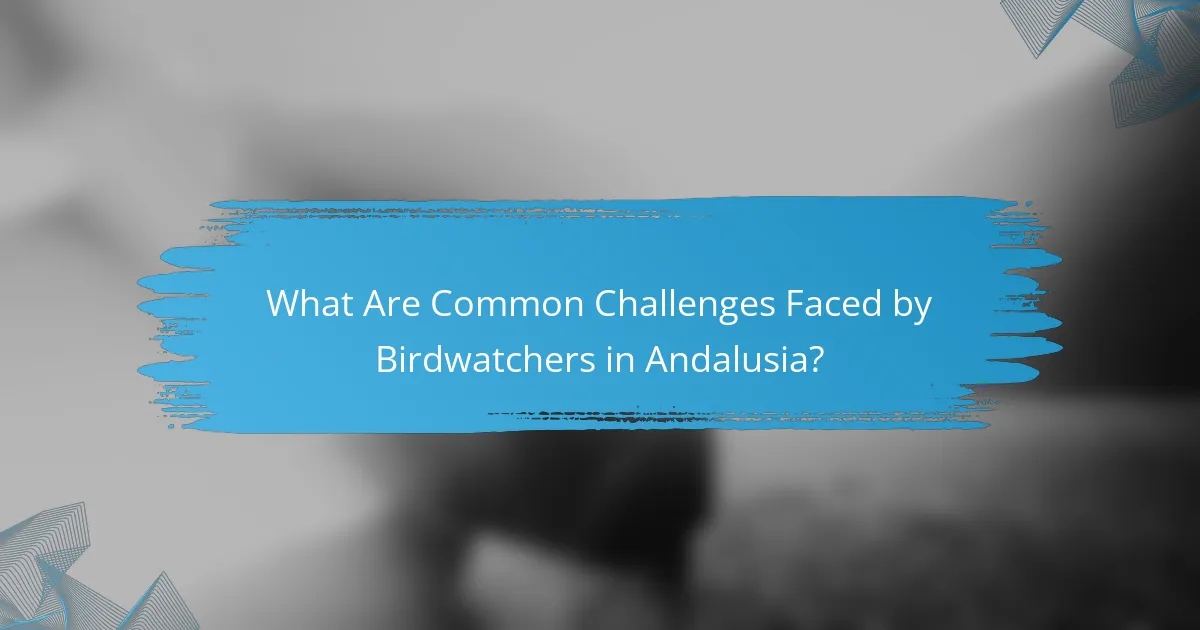
What Are Common Challenges Faced by Birdwatchers in Andalusia?
Birdwatchers in Andalusia face several common challenges. Limited access to remote birding locations can hinder exploration. Seasonal weather variations may affect visibility and bird activity. Additionally, the presence of invasive species can disrupt local ecosystems, making it harder to spot native birds. Lastly, the lack of adequate resources or guides can limit the overall birdwatching experience.
How to Navigate Weather Variability During Birdwatching Trips?
To navigate weather variability during birdwatching trips in Andalusia, plan for changing conditions. Monitor forecasts closely and choose locations with diverse habitats.
Consider visiting wetlands like Doñana National Park for waterfowl during rainy seasons. Coastal areas such as the Strait of Gibraltar attract migratory birds, especially in spring and autumn.
Bring appropriate gear, including waterproof clothing and binoculars with good light transmission. Be flexible with your schedule to adapt to sudden weather changes, ensuring you maximize birdwatching opportunities.
What Precautions Should Birdwatchers Take to Respect Wildlife?
Birdwatchers should maintain a respectful distance from wildlife to minimize stress and disruption. Avoid loud noises and sudden movements, which can disturb birds. Use binoculars instead of approaching closely, and stay on designated paths to protect habitats. Limit time spent in sensitive areas, especially during nesting seasons.
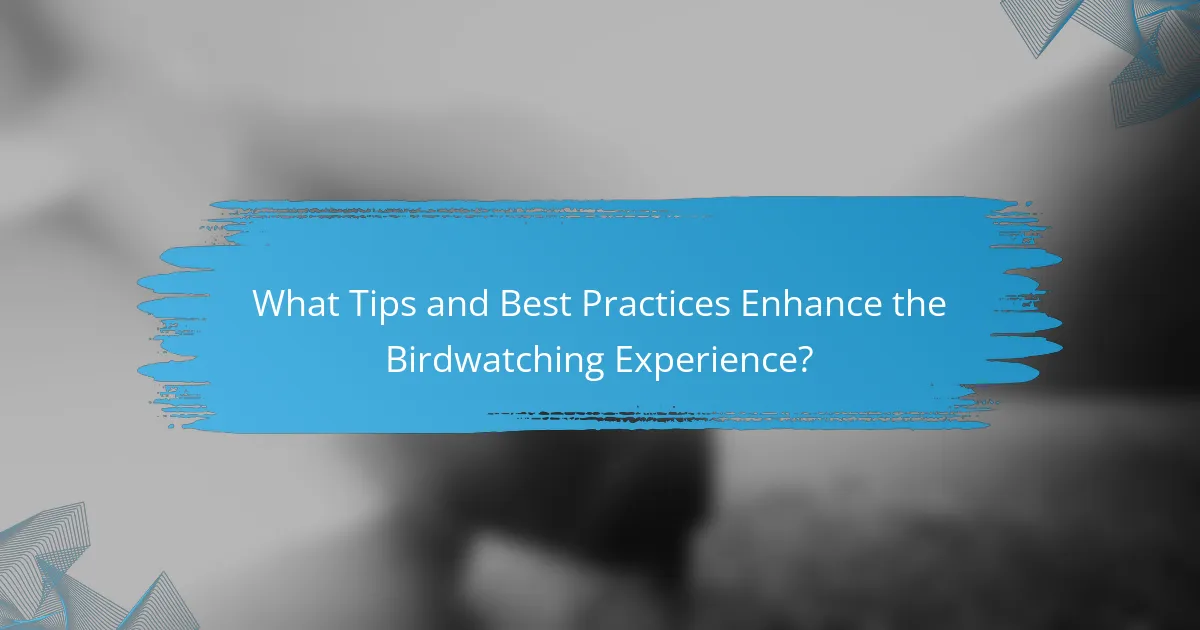
What Tips and Best Practices Enhance the Birdwatching Experience?
To enhance the birdwatching experience in Andalusia, focus on preparation, location, and timing.
1. Research local species to identify which birds are present in different seasons.
2. Choose prime locations such as Doñana National Park or the Sierra de Grazalema for diverse sightings.
3. Opt for early mornings or late afternoons when birds are most active.
4. Use quality binoculars and field guides to improve identification skills.
5. Practice patience and remain quiet to avoid startling birds.
6. Join local birdwatching groups for shared knowledge and experiences.
How to Create a Birdwatching Checklist for Andalusia?
To create a birdwatching checklist for Andalusia, identify key locations, species, and seasonal highlights. Start by selecting top birdwatching sites like Doñana National Park and Sierra de Grazalema. Include notable species such as the Spanish Imperial Eagle and the Eurasian Hoopoe. Consider seasonal migrations, noting which birds are present during spring and autumn. Documenting these elements will enhance your birdwatching experience in Andalusia.
What Resources Are Available for Birdwatching Guides and Tours?
Numerous resources are available for birdwatching guides and tours in Andalusia. Local organizations offer guided tours, while online platforms provide detailed information on birdwatching locations and species. Popular guides include the Andalusian Birdwatching Association and regional tour operators specializing in birding experiences. Additionally, mobile apps like Merlin Bird ID enhance the birdwatching experience by identifying species and providing insights on seasonal highlights.